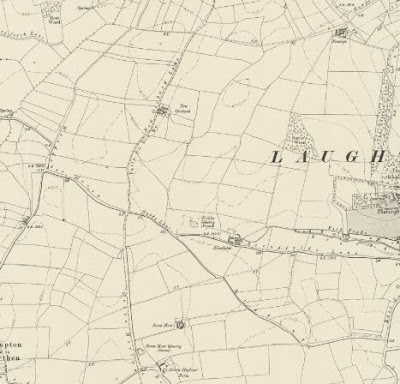 |
| A village entrance marker on Green Arbour Road |
A few days after my walk around Wickersley, to take a look at its geology, historic architecture and St. Alban’s church, I took advantage of the continuing good weather in the last week of October 2021 to explore another part of Rotherham that I had never visited before – this time entailing a walk from Thurcroft to Wickersley via Brampton-en-le-Morthen and Morthen.
When passing through Thurcroft a couple of times on the No. 19 bus from Rotherham on the way to see the mediaeval churches in Laughton-en-le-Morthen and Throapham, I didn’t notice anything of interest - except the tower of the Church of St. Simon and St. Jude.
On this occasion, with my route being planned to include 21 buildings to photograph for the British Listed Buildings website – including 3 in Thurcroft - this would as usual enable me to get a good appreciation of the underlying geology, as seen in the building stones, which in this area is the Pennine Upper Coal Measures Formation (PUCMF), with the principal named sandstone in the area being the Dalton Rock.
Arriving at the Church of St. Simon and St. Jude, built in 1937 to the design of an unknown architect, I didn't give much thought to the masonry that I could see from a distance when I found my way to it, having alighted from the bus on Katherine Road.
Looking closely at the walling, however, I was surprised to discover that the church is not built with sandstone, but a very coarse grained artificial stone. I had encountered similar materials before, but most of these have a flush surface and not a finish that looks exactly like rock-faced stone – which I can’t envisage how was achieved.
Making my way to Green Arbour Road, I set off in the hope of photographing the Grade II Listed Sawn Moor Farmhouse and its associated complex of farm buildings which, looking on Google Street View, looked quite secluded and not easy to see.
This mid-late farmhouse is shown on the 1855 Ordnance Survey map as being less than 250 metres away from the Sawn Moors sandstone quarry, which is set on an unnamed sandstone from the PUCMF. As expected, I couldn’t get anywhere near the buildings but, from photos taken with my zoom lens, I can quite clearly see that a considerable proportion of the stonework is reddened – sometimes with a plum colour.
Returning to Green Arbour Road, I stopped to look at a castellated boundary wall, which is similar to others that were presumably built at the same time as the housing for the colliery workers and the new school, which appear on the 1930 edition of the Ordnance Survey map.
Although the capping stones appear to be made of sandstone of a reasonable quality, most of the walling is silty and quite soft and varies from grey to pink in colour. The PUCMF sandstones, where occurring just below the Carboniferous/Permian unconformity, are often partially reddened, due to the oxidation of iron bearing minerals in the arid Permian climate and this may account for the colour of some sandstones seen on my walk – including the outbuildings at Green Arbour Farm.
The next building on my list to photograph was the late C17 Green Arbour Farm Cottage, which is built in a light brown sandstone, with some iron bands and staining, which is more typical of the Coal Measures sandstones than the reddened varieties.
Having spent no more than 30 minutes in Thurcroft, I took a photo of a distinct ridge formed by the Dalton Rock, one of the prominent sandstones in the PUCMF, before finding the public footpath that would take me to Brampton-en-le-Morthen.











No comments:
Post a Comment